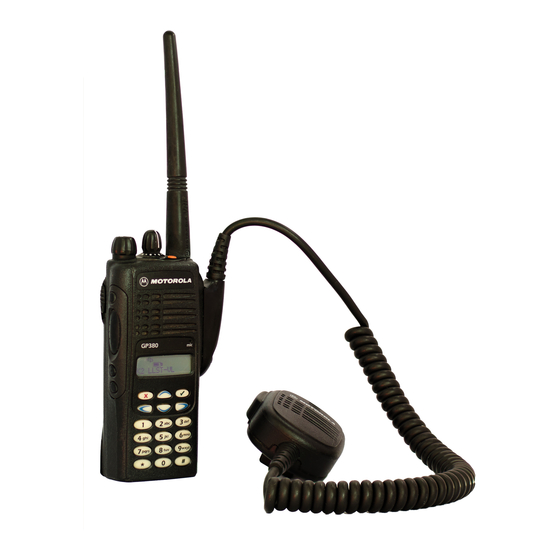Motorola GP series Servis Kılavuzu - Sayfa 5
Radyo Motorola GP series için çevrimiçi göz atın veya pdf Servis Kılavuzu indirin. Motorola GP series 26 sayfaları. Professional radio
Ayrıca Motorola GP series için: Hizmet Bilgileri (24 sayfalar), Hizmet Bilgileri (31 sayfalar), Hizmet Bilgileri (43 sayfalar), Hizmet Bilgileri (30 sayfalar), Kullanıcı Kılavuzu (16 sayfalar), Manuel (30 sayfalar)

SAFETY AND GENERAL INFORMATION
IMPORTANT INFORMATION ON SAFE AND EFFICIENT OPERATION
Read this infomation before using your radio.
The information provided in this document supersedes the general safety information contained in user guides
published prior to July 2000. For information regarding radio use in a hazardous atmosphere please refer to the
Factory Mutual (FM) Approval Manual Supplement or Instruction Card, which is included with radio models that
offer this capability.
Radio Frequency (RF) Operational Characteristics
To transmit (talk) you must push the Push-To-Talk button; to receive (listen) you must release the Push-To-Talk
button. When the radio is transmitting, it generates radio frequency (RF) energy; when it is receiving, or when it
is off, it does not generate RF energy.
PORTABLE RADIO OPERATION AND EME EXPOSURE
Your Motorola radio is designed to comply with the following national and international standards and guidelines
regarding exposure of human beings to radio frequency electromagnetic energy:
United States Federal Communications Commission, Code of Federal Regulations; 47 CFR part 2 sub-part J
G
American National Standards Institute (ANSI) / Institute of Electrical and Electronic Engineers (IEEE)
G
C95. 1-1992
Institute of Electrical and Electronic Engineers (IEEE) C95.1-1999 Edition
G
National Council on Radiation Protection and Measurements (NCRP) of the United States, Report 86, 1986
G
International Commission on Non-Ionizing Radiation Protection (ICNIRP) 1998
G
Ministry of Health (Canada) Safety Code 6. Limits of Human Exposure to Radiofrequency Electromagnetic
G
Fields in the Frequency Range from 3 kHz to 300 GHz, 1999
Australian Communications Authority Radiocommunications (Electromagnetic Radiation - Human Exposure)
G
Standard 1999 (applicable to wireless phones only)
To assure optimal radio performance and make sure human exposure to radio frequency electromagnetic energy
is within the guidelines set forth in the above standards, always adhere to the following procedures:
Phone operation
When placing or receiving a phone call, hold your phone as you would a wireline telephone. Speak directly into
the microphone.
Two-way radio operation
When using your radio hold the radio in a vertical position with the microphone 2.5 to 5 cm away from the lips.
Body-worn operation
To maintain compliance with FCC RF exposure guidelines, if you wear a radio on your body when transmitting,
always place the radio in a Motorola approved clip, holder, holster, case, or body harness for this product. Use of
non-Motorola-approved body worn accessories may exceed FCC RF exposure guidelines. If you do not use a
Motorola approved body-worn accessory and are not using the radio in the intended use positions along side of
the head in the phone mode or in front of the face in the two-way radio mode, then ensure the antenna and radio
is kept the following minimum distances from the body when transmitting:
Phone or Two-way radio mode: 2.5 cm (one inch)
G
Data operation using any data feature with or without an accessory cable: 2.5 cm (one inch) .
G
Antenna Care
Use only the supplied or an approved replacement antenna. Unauthorized antennas, modifications, or
attachments could damage the radio and may violate FCC regulations.
DO NOT hold the antenna when the radio is "IN USE". Holding the antenna affects call quality and may cause
the radio to operate at a higher power level than needed.
Approved Accessories
For a list of approved Motorola accessories please contact your dealer or local Motorola representative.
v
